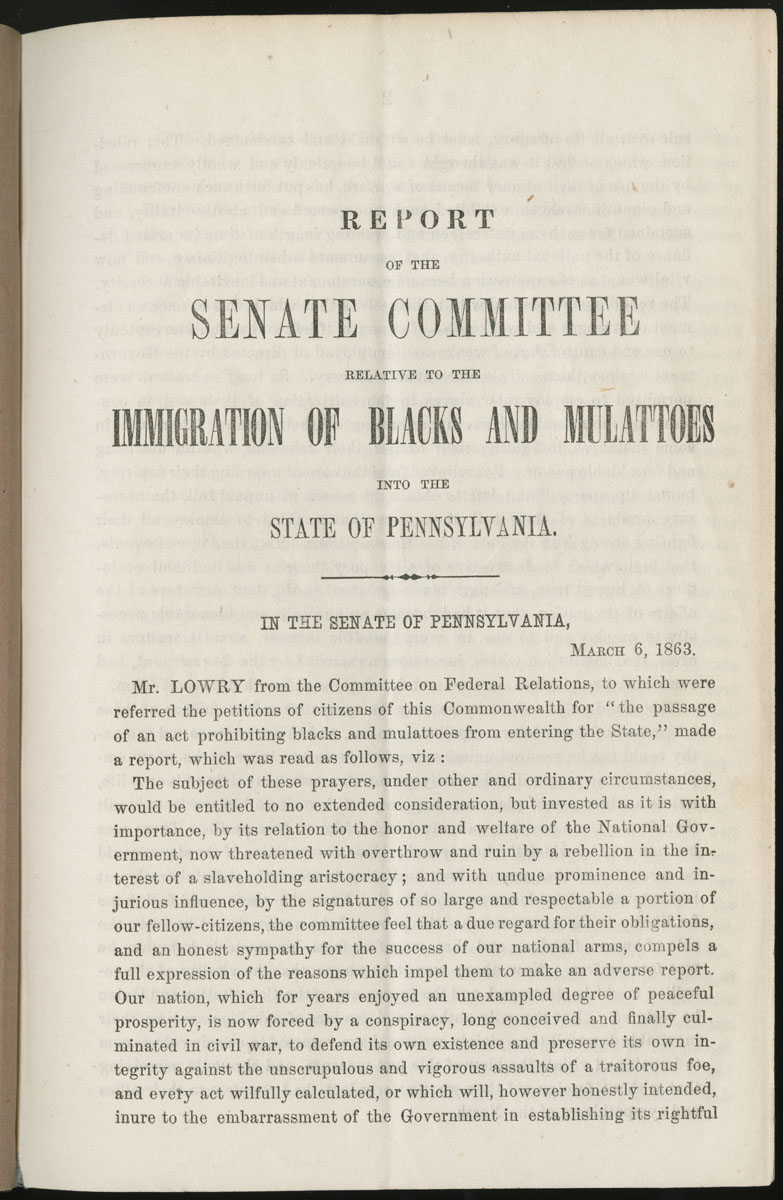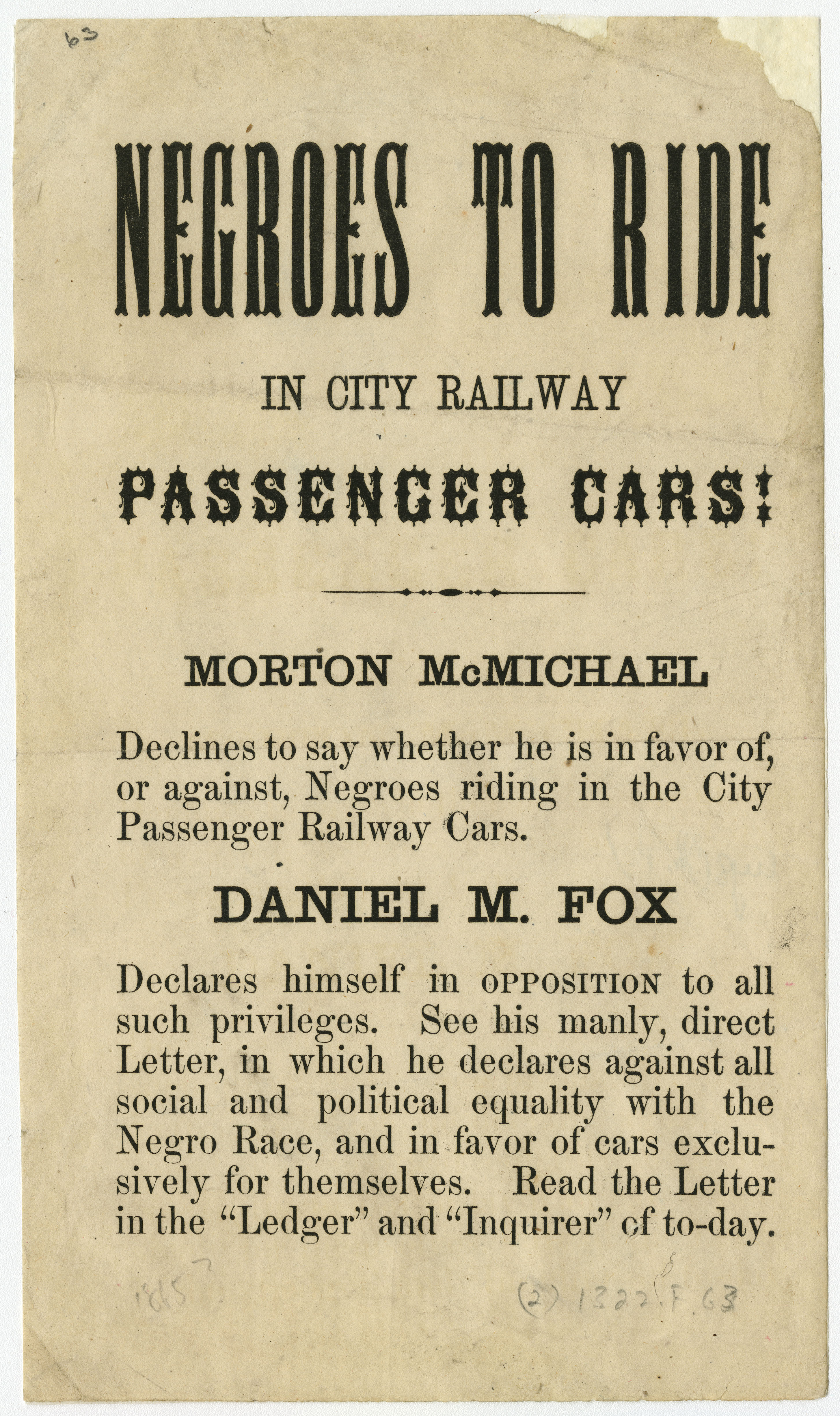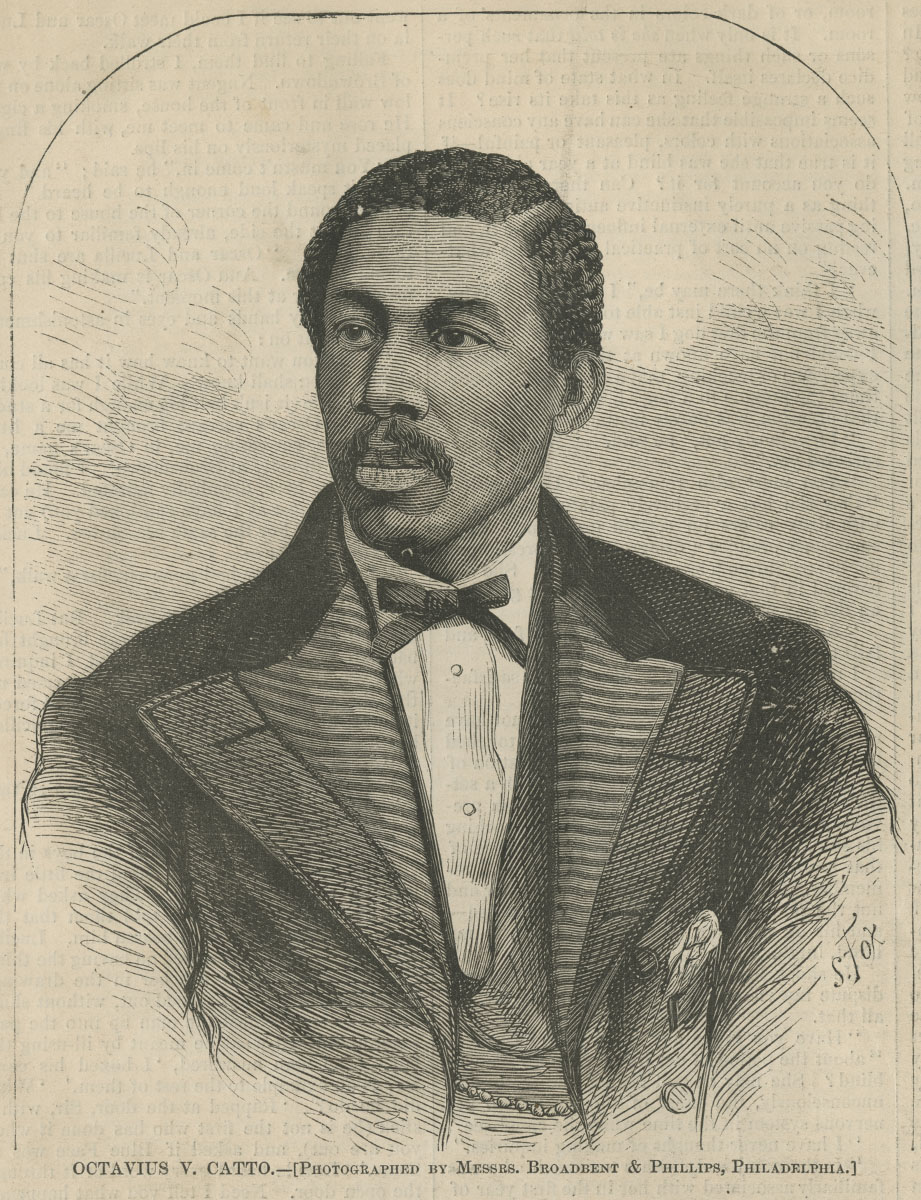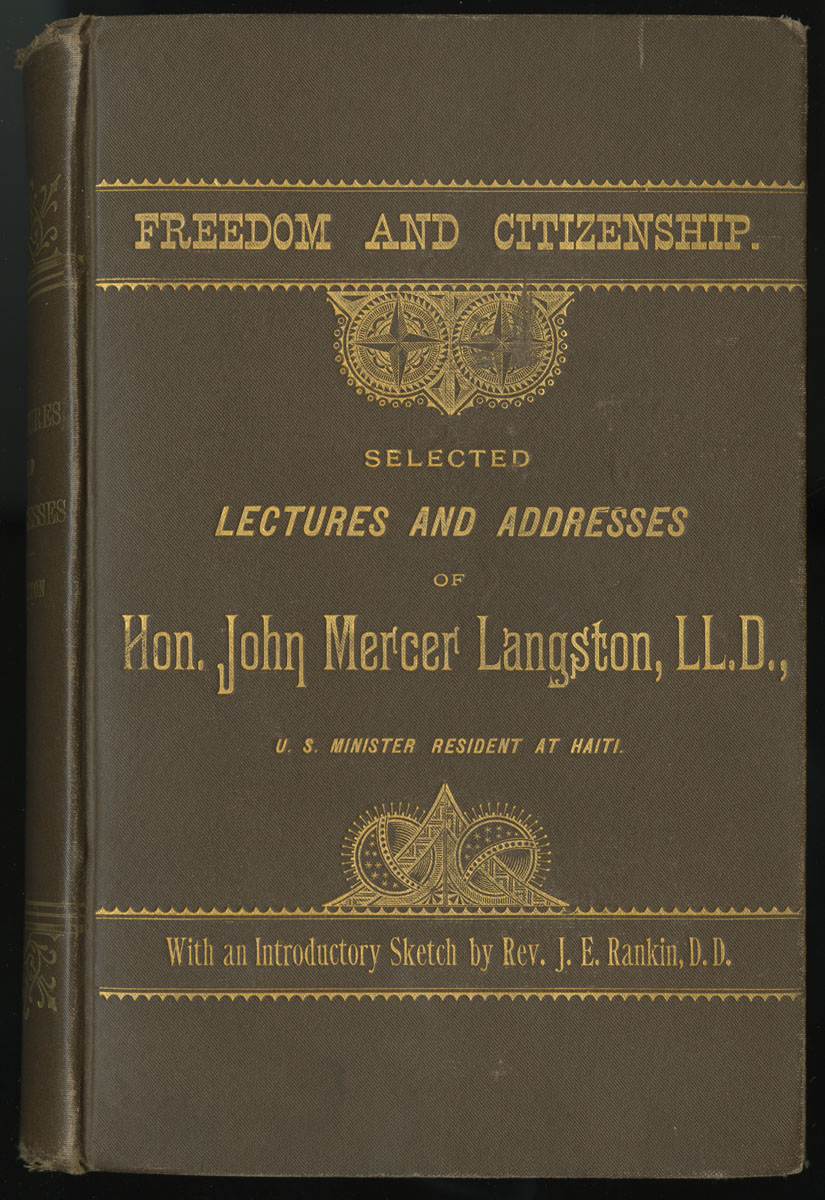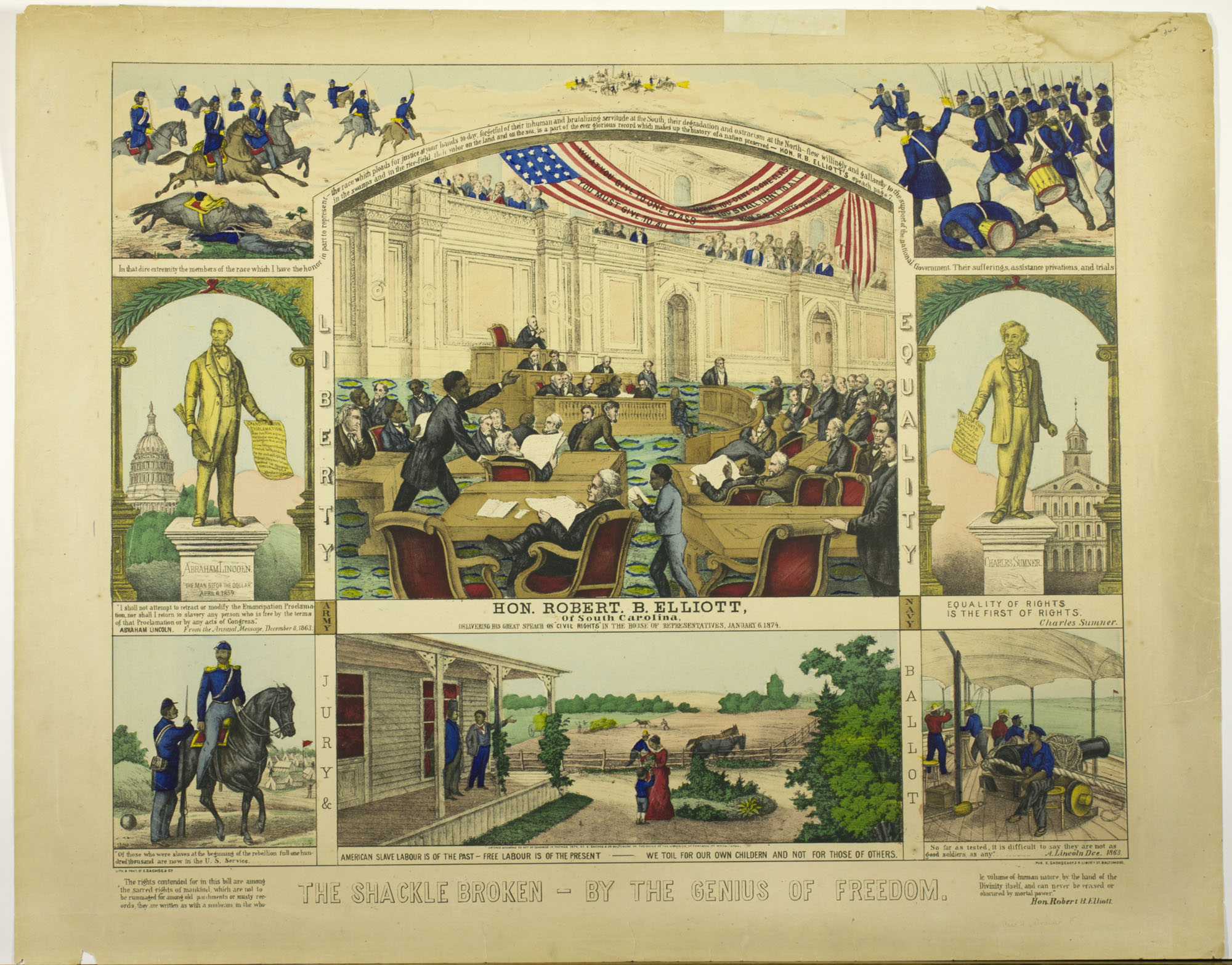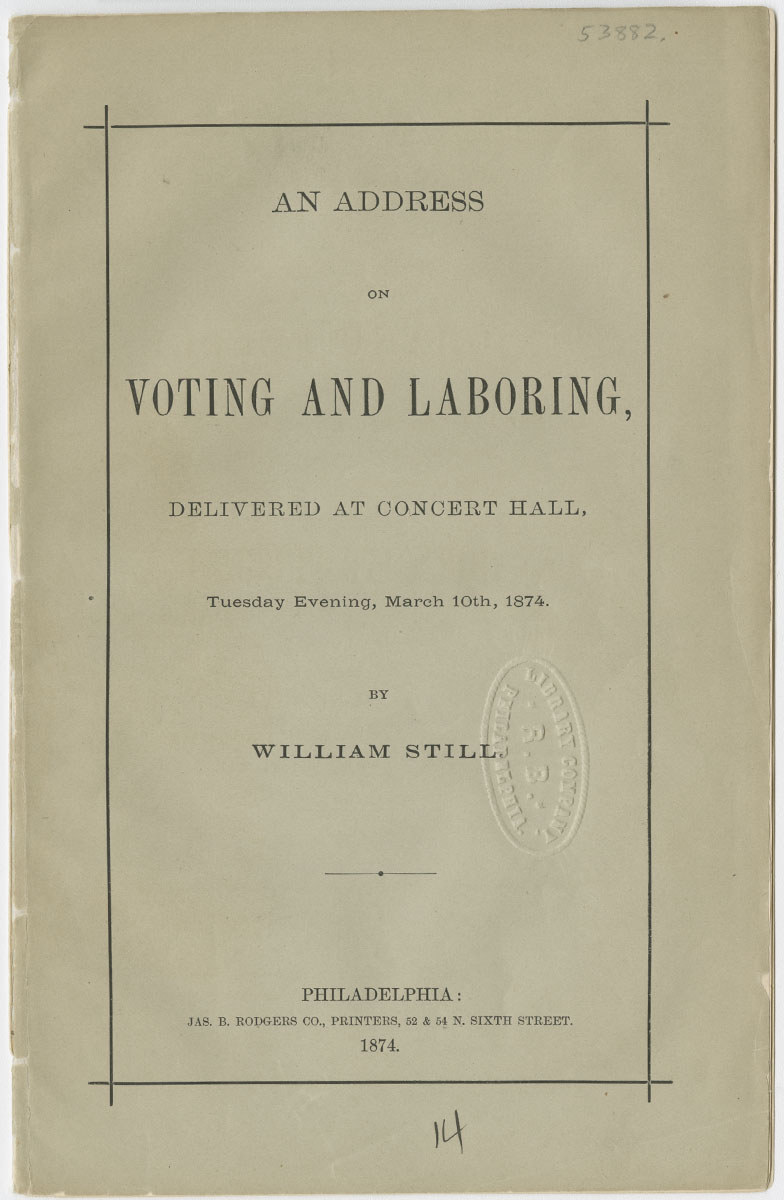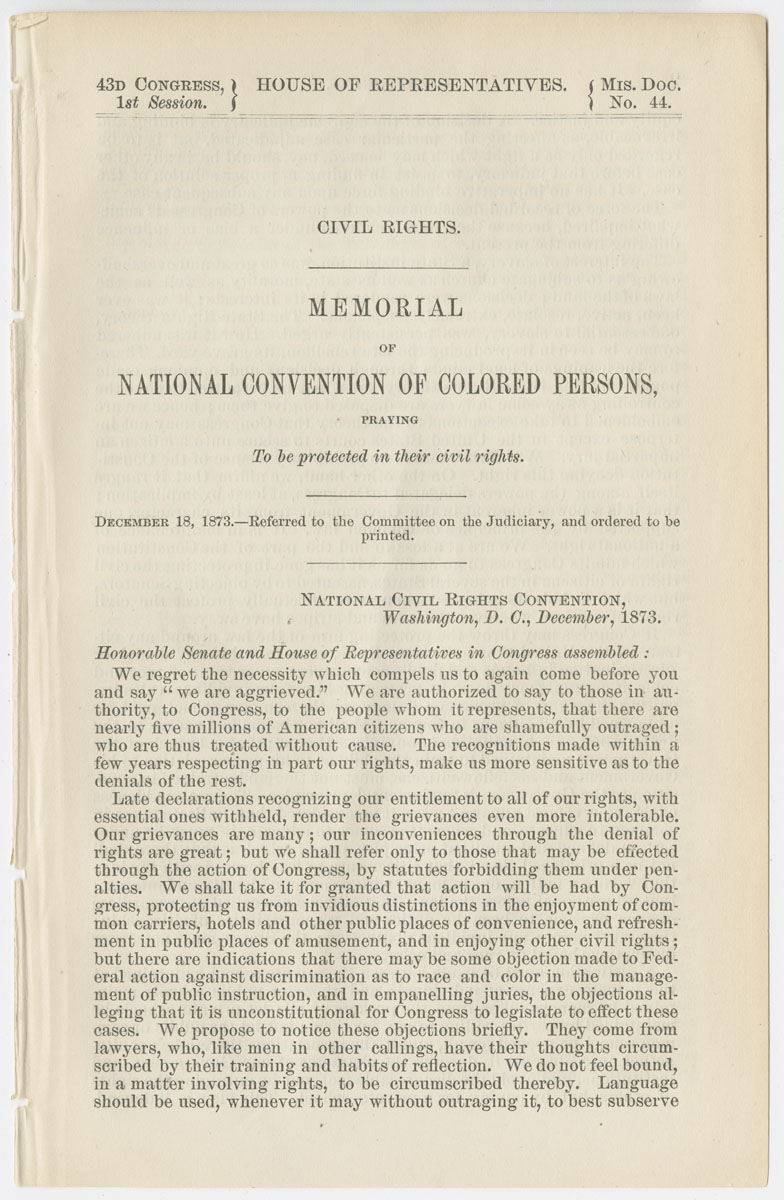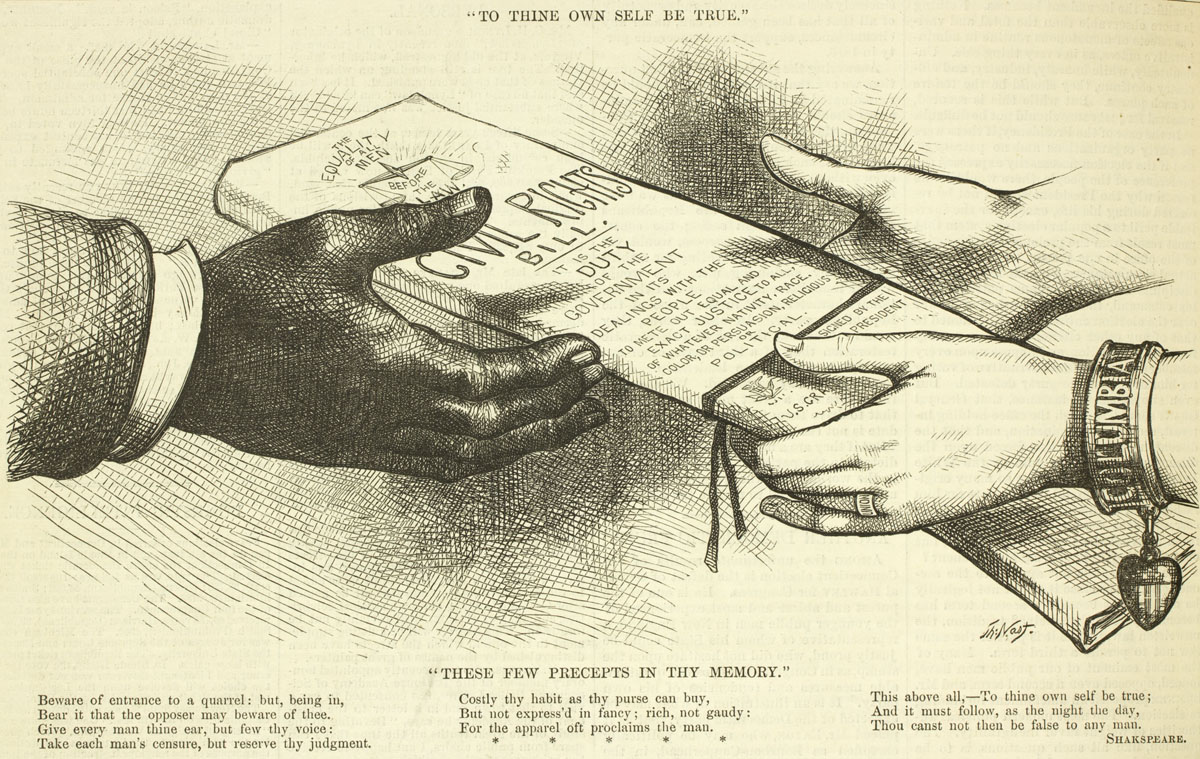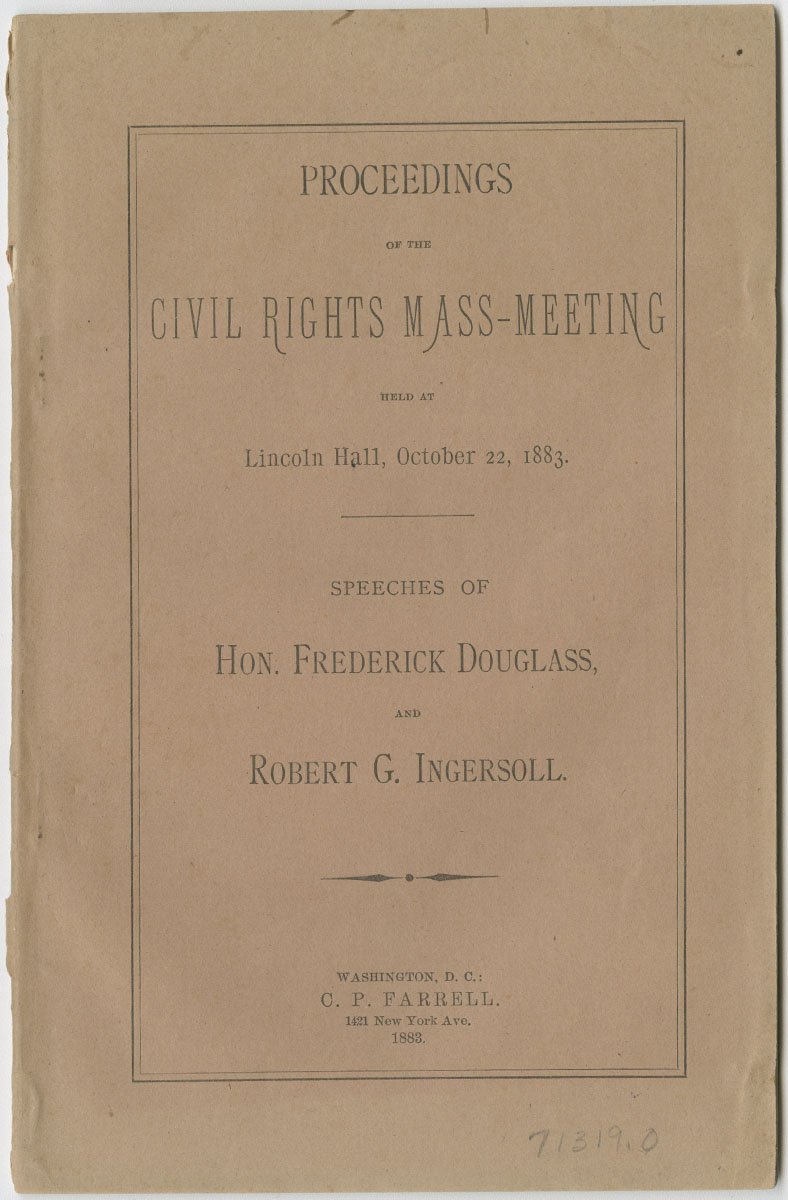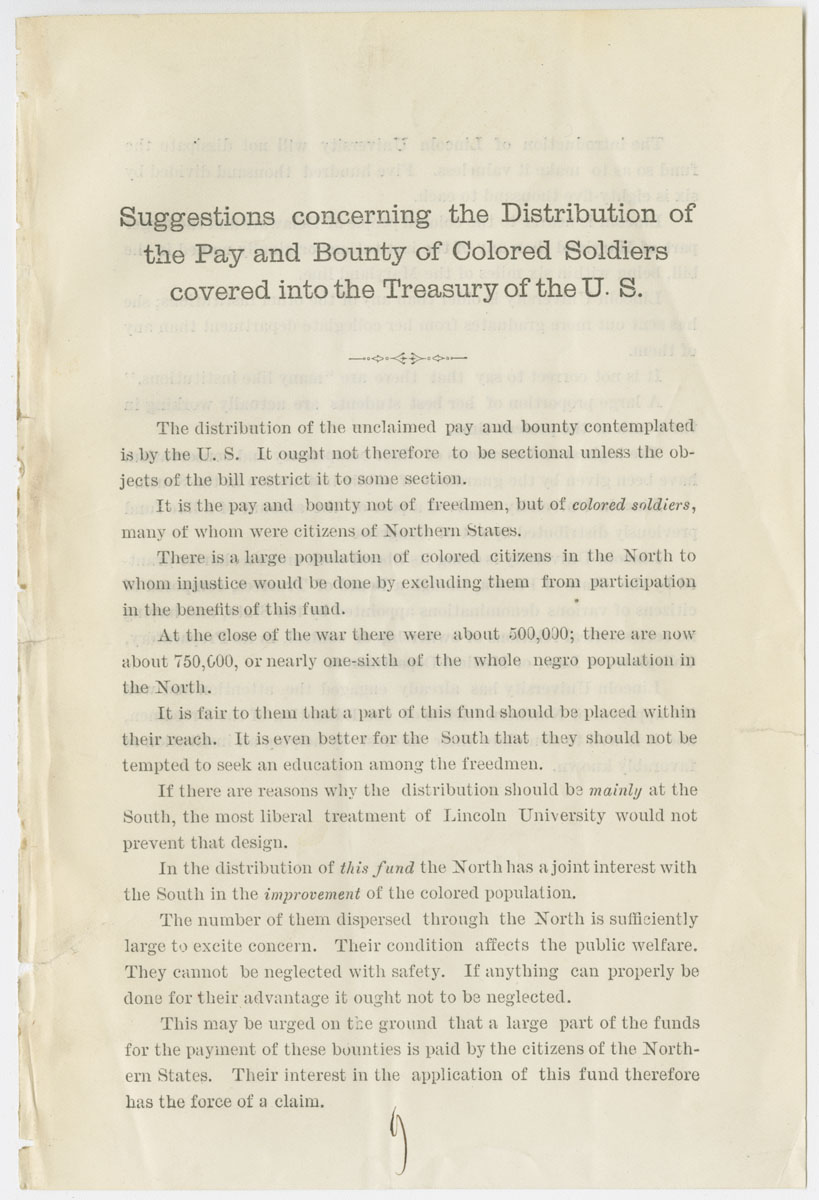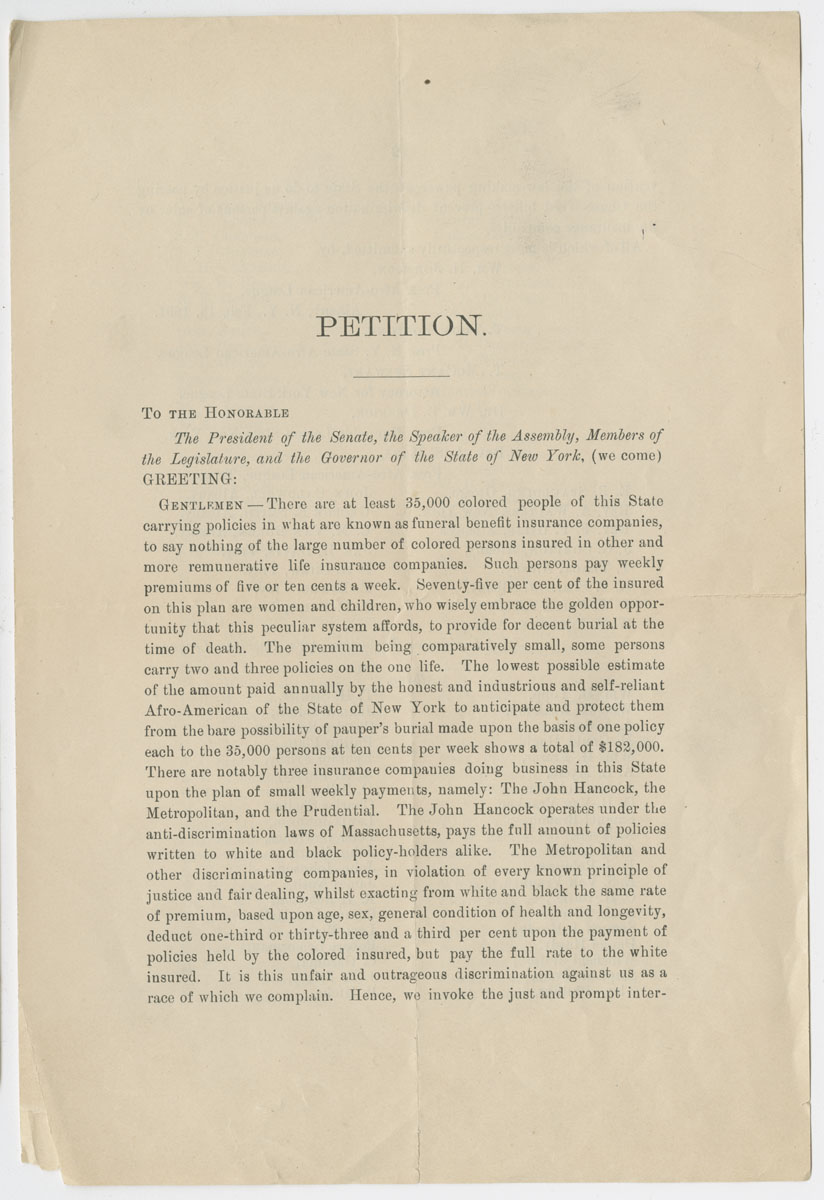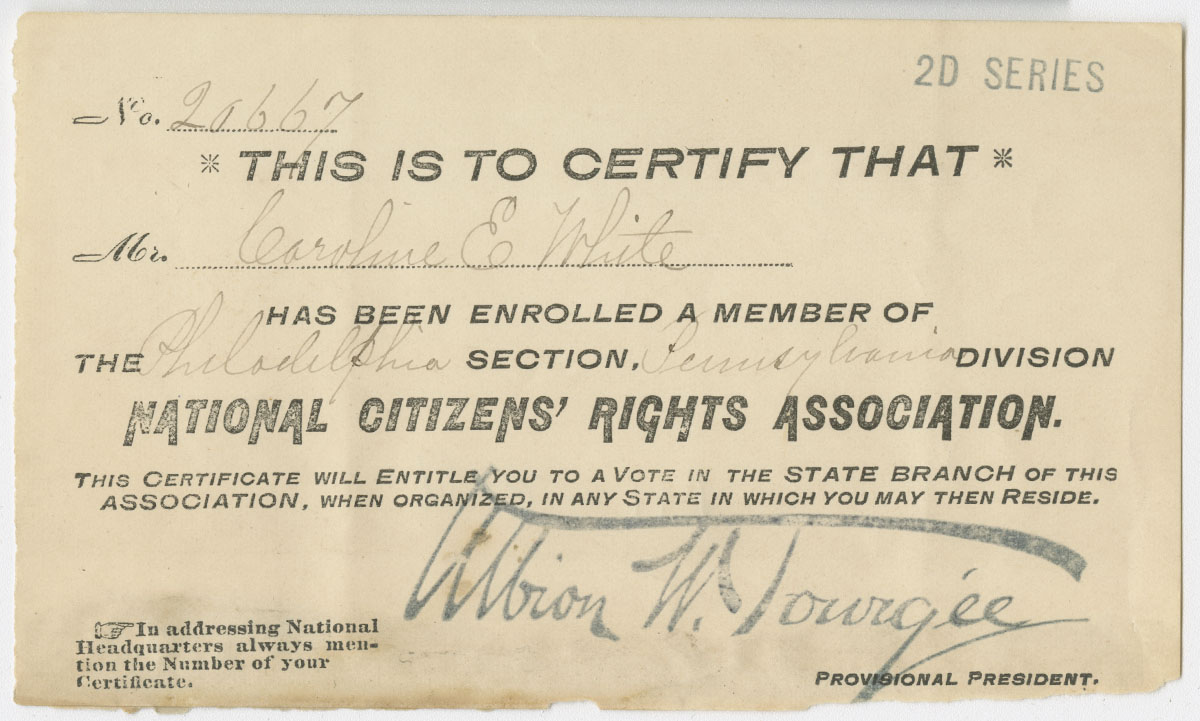To the General Assembly of the State of Ohio. Coshocton, 1861.
In this petition to the state assembly shortly before the start of the Civil War, a group of white residents expressed sympathy for those fleeing slavery and the need for temporary asylum in the state. Nevertheless, since they believed “it [was] not desirable to increase this class of inhabitants” on a permanent basis, the petitioners requested that the General Assembly pass a resolution urging Congress to settle free and manumitted blacks in Africa. Although the General Assembly did not pursue colonization, local laws mandating segregation in schools, employment, and housing often made Ohio an inhospitable place for African Americans in the post-war era.
Report of the Senate Committee Relative to the Immigration of Blacks and Mulattoes into the State of Pennsylvania. Harrisburg: Singerly & Myers, 1863.
Despite Pennsylvania’s strong abolitionist movements, following the Emancipation Proclamation the General Assembly received several petitions asking that the influx of African American immigrants be restricted. A Pennsylvania State Senate committee investigated the issue and released this report in response, recommending that freed slaves be welcomed, “for every slave we wrest from treason, we take one soldier.”
Ninth Biennial Report of the Superintendent of Public Instruction of the State of Illinois: 1871-1872. Springfield, 1872.
Access to public schools in the North varied widely. While schools in New England were racially integrated, other states, such as Illinois, required black students to attend separate schools. The Illinois school superintendent devoted several pages of his 1872 report to this former injustice. Citing a new state law guaranteeing equal access, he stressed that “All the youth of the State are, and henceforth shall be, equal before the law, in respect to their claims to a good common school education.” To deter exclusionary practices, he recommended that the General Assembly enact stiffer penalties for denying admission to schools.
Thirty-Third Annual Report of the Superintendent of Public Instruction of the State of Michigan. Lansing: W. S. George & Co., 1869.
African Americans petitioned city councils and state legislatures as well as sued in the courts for the right for their children to attend public schools. In this annual report, the Superintendent summarized a court case in which a black father sued for his child’s right to attend a segregated public school. The case had statewide implications as the Michigan Supreme Court decided that under state statute, African Americans were entitled to apply for admission to any school in their districts.
Negroes to Ride in City Railway Passenger Cars! Philadelphia, 1866.
Black Philadelphians challenged discriminatory laws and practices on a number of fronts, including on the city’s privately run streetcars. Following company policy as well as their own inclinations, drivers either refused to pick up African Americans or forced them to ride on the cars’ outdoor platforms, regardless of the weather. Issues such as this became touchstones in local politics, helping to sway white voters who were opponents of social and political equality for blacks. Octavius Catto, William Still, Caroline Le Count, Harriet Forten Purvis, and Congressman William D. Kelley led protests, leading to the passage of an 1867 state law prohibiting racial segregation on streetcars.
“Octavius Catto.” Harper’s Weekly (Oct. 28, 1871).
Educator and civil rights activist Octavius Catto strove to insure the franchise for Philadelphia African Americans. In 1871, in preparation for the first major city election following the passage of the Fifteenth Amendment, Catto monitored polling places and encouraged African Americans to cast their ballots. In the days preceding the election, in order to intimidate the mostly Republican black voters, the local Democratic mayor and his political machine fomented violence which led to the murder of several black men. On Election Day, October 10, 1871, Frank Kelly, a Democrat, followed Catto home and fatally shot him. Despite the violence, African American voter turnout resulted in a Republican sweep of most city offices.
John Mercer Langston. Freedom and Citizenship: Selected Lectures and Addresses of Hon. John Mercer Langston. Washington, DC: Rufus H. Darby, 1883.
John Mercer Langston. From the Virginia Plantation to the National Capitol, or the First and Only Negro Representative in Congress from the Old Dominion. Hartford, CT: American Publishing Company, 1894.
Born free in Virginia in 1829, John Mercer Langston (1829-1897) was raised and educated in Ohio, where he attended Oberlin College. In 1864, he was elected president of the National Equal Rights League, whose campaign for black suffrage helped ensure the passage of the Fifteenth Amendment. Much of Langston’s abolitionist and civil rights career was spent in the North. However, a return to the South made possible his election to Congress, where he served a short stint from 1890 to 1891.
The Shackle Broken–By the Genius of Freedom. Baltimore: E. Saches & Co., 1874.
Despite the passage of the Reconstruction Amendments and a history of activism, the small numbers of African Americans in Northern states meant that their political influence was diluted at the national level.
Robert B. Elliott (1842-1884) was one of several non-Southern black men who served in Congress through election from a Southern state. His origins are murky, but he may have been born in Boston or Liverpool, England, to West Indian parents. By 1867, he was living in Charleston, where he became a vocal leader in Republican politics. One of 78 black delegates to South Carolina’s 1868 constitutional convention, Elliott was elected to the U.S. House of Representatives in 1871 and 1873. During his second term, he gained national attention after giving a passionate speech in the House in support of Senator Charles Sumner’s civil rights bill.
William Still. An Address on Voting and Laboring. Philadelphia: Jas. B. Rodgers Co., 1874.
In 1874, William Still (1821-1902) and Robert Purvis (1810-1898) were among a number of prominent black Philadelphians who came under attack for supporting mayoral candidate Alexander K. McClure, a member of the People’s Party, rather than the Republican candidate. Some black Philadelphians accused Still of “having turned traitor to our principles.” In this public speech defending his decision, Still chastised the Republican Party for taking black support for granted instead of earning that support by furthering black interests. In particular, Still noted that African Americans faced prejudice in employment, an issue not well addressed by the Republican candidate.
Memorial of the National Convention of Colored Persons, Praying to be Protected in Their Civil Rights. Washington, DC, 1873.
Three years after the passage of the Fifteenth Amendment, African Americans still found their hold on many of their rights to be precarious. George T. Downing, a black caterer in Rhode Island, led state and national campaigns to demand constitutional rights for African Americans. Downing’s use of the word “authorized” demonstrates the extent to which the conventions functioned as a form of democratic representation that African Americans were often denied in formal political processes. Contrast this with the response of Jacob D. Cox in the previous section of this exhibition. Cox, a candidate for Ohio governor, dismissed the petition for African American suffrage, partly because he felt that the petitioners had not been vested with organizational authority for their appeal.
Augustus Robin. Charles Sumner: “Do Not Let the Civil Rights Bill Fail.” New York, ca. 1874.
An abolitionist and Radical Republican, Senator Charles Sumner (1811-1874) of Massachusetts was a long-time champion of African American civil rights. During Reconstruction, he introduced a number of bills in the Senate to guarantee and expand rights for African Americans and to limit the power of supporters of the former Confederacy. The last of these became known as the Civil Rights Act of 1875, which was passed a year after his death.
“To Thine Own Self Be True.” Harper’s Weekly (April 24, 1875).
In 1870, Senator Charles Sumner and John Mercer Langston, then head of Howard University’s Law Department, co-authored a civil rights bill. After many years of campaigning, the bill was signed into law on March 1, 1875, as commemorated in this cartoon. The Civil Rights Act of 1875 guaranteed equality in public accommodations and public transportation and prohibited exclusion from jury service. The victory was short-lived as the Supreme Court declared the Act unconstitutional in 1883. The Court ruled that the Constitution did not grant the federal government the power to prohibit discrimination by private individuals, a key component of the Act.
Frederick Douglass. Proceedings of the Civil Rights Mass-Meeting Held at Lincoln Hall. Washington, DC: C.P. Farrell., 1883.
In 1883, a Supreme Court decision declared the 1875 Civil Rights Act, which prohibited discrimination in hotels, trains, and other public spaces, to be unconstitutional since such oversight remained a right of the states. Appalled by the Supreme Court’s ruling, African Americans held a rally in Washington, DC. Frederick Douglass, one of the rally’s main speakers, noted that Northern newspapers inflamed public opinion by declaring the Act a social rights bill, which would force social equality between the races. These tactics illustrate prevailing fears among Northerners about the potential impact of federal civil rights legislation.
Suggestions Concerning the Distribution of the Pay and Bounty of Colored Soldiers Covered into the Treasury of the US. 1868.
Black Civil War veterans did not always claim the money due to them for their service because of death or lack of proper paperwork. The most frequent suggestion in Congress and the black community for use of the funds was educational or training initiatives for freed people. The anonymous author of this petition argues that distributing some of these funds to Lincoln University would serve both Northern African Americans and newly freed slaves. This petition recognized that post-war reparations needed to address injustice towards African Americans in the North as well as the South.
Afro-American League. Petition to the Honorable the President of the Senate. Albany, NY, 1891. Courtesy of the Historical Society of Pennsylvania.
Black insurance policy holders in New York received only two-thirds of their policy payments while whites received the entire amounts. In 1891, the Chase-Ward Bill was introduced in the New York General Assembly to end this discriminatory practice by insurance companies. The Afro-American League in Albany submitted this petition urging support of the bill, which was later passed unanimously. Reference to the Hancock policy in Massachusetts demonstrates how inconsistently laws and policies were applied to African Americans from state to state in the North. In existence only from 1887 through 1893, the National Afro-American League was a short-lived organization. However, local chapters, such as this Albany one, had more success in challenging discriminatory practices than the national league.
Membership card for the National Citizens’ Rights Association. ca. 1891. Courtesy of the Historical Society of Pennsylvania.
Civil rights organizations were often short-lived due to leadership vacuums, financial difficulties, and ideological differences. New organizations continued to be established as the need to protect African American rights remained constant. Albion Tourgee, a white civil rights activist, writer, and lawyer, founded the National Citizens’ Rights Association in 1891 as an interracial organization. Black Philadelphian members included Dr. Nathan F. Mossell, Henry Ossawa Tanner, Matthew Anderson, and Caroline E. White, wife of Philadelphia educator Jacob C. White, whose membership card is displayed here. By 1895, the National Citizens’ Rights Association had suffered the fate of previous organizations of its kind and withered away.


